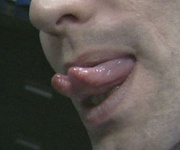Split tongue
Tongue splitting procedure is the central bifurcation of the tongue, so as to achieve a "forked tongue." With practice, each half can be separately controlled.
Placement
The median fibrous septum that centrally divides the tongue is cut, separating the two lateral halves of the tongue. Done carefully, very little damage should be done in the process.
The tongue can, in theory, be split back to where it meets the base of the mouth. Attempting to split past that would endanger muscles that shouldn't be split, as well as glandular structures in the area. Note again that once the tongue is split further than suggested, there may be some minor speech artifacts.
It is not a good idea to cut the tongue in more than two pieces. To do so would risk cutting into the lingual nerves, the lingual glands, numerous major blood vessels, and it is dubious whether full nervous control could be sustained even if done by an oral surgeon. Attempting a "trifuraction" (or more) would almost certainly end in disaster.
Procedure
Tongue splitting can be accomplished by one or more of the following methods:
Oral surgery
The most recommended method is to seek an oral surgeon. Any oral surgeon who uses a laser should be able to bifurcate a tongue with ease, providing their ethics allow it. A doctor will normally charge between $500 and $3000 for this procedure. After applying anesthesia, using a laser, the practitioner will first create a guideline along the top and bottom of the tongue. Then, they'll slowly cut through the tissue until the tongue is fully bifurcated, cauteri... [ extended content is printed here, remove this placeholder and continue converting from here ]
